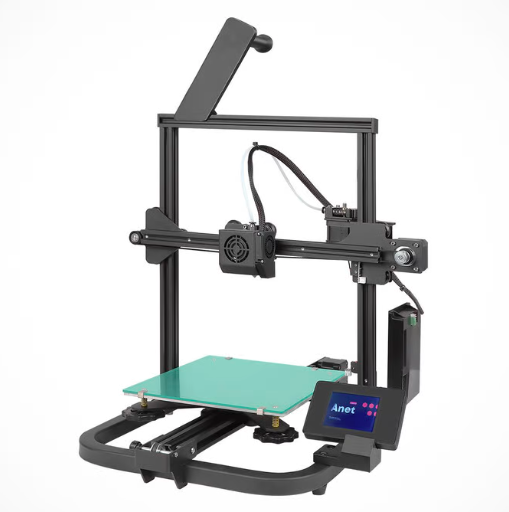Compare Ender 3 vs A8 V2
Comparison between the best 3D printers
Choose the best 3D printer at the best price. The cheapest 3D printers are here.
Buy a 3D printer here with 3D Fila.
 |
 |
|
| Model | Ender 3[BUY Ender 3] |
A8 V2 |
| Printing Material | Filament | Filament |
| Buy Filament for Creality 3D Ender 3 | Buy Filament forAnet A8 V2 | |
| Estimated price | $210,00 | $129,00 |
| Manufacturer | Creality 3D | Anet |
| Release Year | 2018 | 2021 |
| Print Volume [mm] | 220x220x250 | 220x220x250 |
| Printer Size [mm] | 440x440x465 | 428x441x486 |
| Weight [kg] | 6,62 | 6,2 |
| Power Loss Recovery | NO | NO |
| Enclosed printer | NO | NO |
| Bed Leveling | Manual | Manual |
| Filament End Sensor | NO | NO |
| Bed type | Heated | |
| Power supply system | Bowden | Bowden |
| Standard nozzle | 0,4 | 0,4 |
| Maximum Nozzle Temperature [°C] | 255 | 230 |
| Maximum Bed Temperature [°C] | 110 | |
| Maximum printing speed [mm/s] | 180 | 150 |
| Filament holder | YES | YES |
| Camera for supervision | NO | NO |
| Recommended filaments | PLA, TPU, ABS, PETG | PLA |
| Recommended slicers | Cura, Simplify, Slic3r | Cura, Simplify, Slic3r, IdeaMaker |
| Maximum Resolution [mm] | 0,1 | 0,1 |
| Processor | 8 bits | |
| Display | Mono | Display touchscreen 2,8'' |
| Power Supply | 24V / 270W | 110/220V / 250W |
| Connectivity | SD / USB | SD / USB |
| Operating systems | Windows, Mac, Linux | Windows, Mac, Linux |
| Date of registration in the system | 2021-04-13 | 2022-11-10 |
| Release date | 2018 | 2021 |
| Extra features | The Ender 3 V1 is a DIY assembly 3D printer, a sales leader since 2017, standing out for its cost-benefit. With a wide printing capacity, it has a CNC machined structure for precision and stability. It offers high-precision prints with low noise, thanks to its innovative V-profile and pulleys. It has a self-adhesive magnetic platform for easy removal of models and excellent adhesion. The Ender 3 heats up quickly, reaching 100°C in 5 minutes, ideal for agile prints. It includes protection against power failures, allowing you to resume printing after interruptions, saving time and material. | The Anet A8 V2 is a Cartesian-XZ type 3D printer with a build volume of 220 x 220 x 250 mm, Ender 3 design and V-slot assembly. It has a 32-bit motherboard and touchscreen interface, promising ease of use. It uses open source firmware and has thermal failure protection. It stands out for its cable organization and the absence of a heated bed, focusing on energy savings and PLA printing. It comes with an external power adapter, aiming at greater safety, especially for beginners and educational use. |
| Support for multiple colors and materials (AMS and CFS) | NO | NO |
Notes * |
||
| Cost-benefit | 6 / 10 | 6 / 10 |
| Hardware | 0.5 / 10 | 0.5 / 10 |
| Tela | . | . |
| Print volume | 3 / 10 | 3 / 10 |
| Performance | 1 / 10 | 1 / 10 |
| [BUY Ender 3] |
Conclusion |
| In comparing the Ender 3 and the Anet A8 V2 3D printers, several key factors come into play, allowing buyers to assess which printer may align best with their needs and budget. Both printers offer the same print volume and are similarly sized, but the Ender 3 excels in several areas. It features a heated bed, which enhances its versatility for a broader range of filament types beyond PLA, including ABS and PETG. This makes it a better choice for users looking to experiment with different materials. The Ender 3 also supports a maximum nozzle temperature that is significantly higher, allowing for more complex printing tasks. In terms of printing performance, the Ender 3 boasts a higher maximum printing speed, which can be beneficial for users aiming to produce prints quickly. Despite having a similar manual bed leveling system and lacking additional sensors for filament detection or power loss recovery, the Ender 3’s design emphasizes stability and precision, which is crucial for achieving high-quality prints. On the other hand, the Anet A8 V2, while being more affordable, primarily focuses on PLA printing and features a touchscreen interface that can enhance user experience, particularly for beginners. However, it lacks the capabilities that come with a heated bed, which may limit its usability for more advanced projects. Ultimately, if budget is a significant concern, the Anet A8 V2 represents an economical option for entry-level users who plan to print primarily with PLA. However, for those who prioritize performance, material versatility, and quality, the Ender 3 emerges as the superior choice, justifying the higher investment with its robust features and proven reliability in the 3D printing community. |

